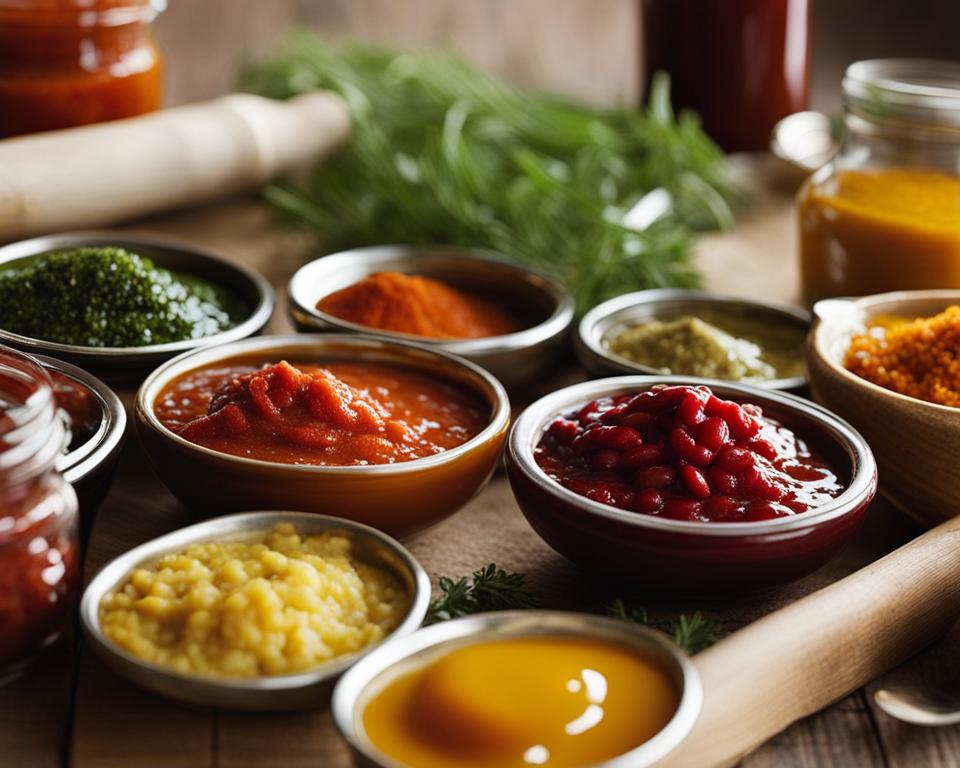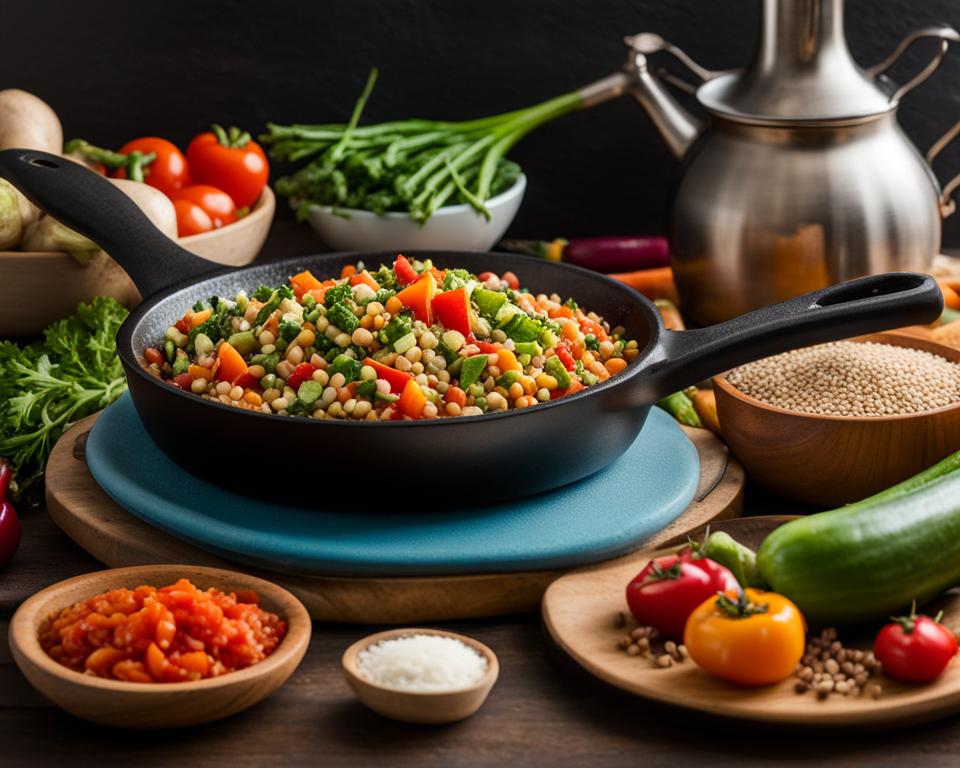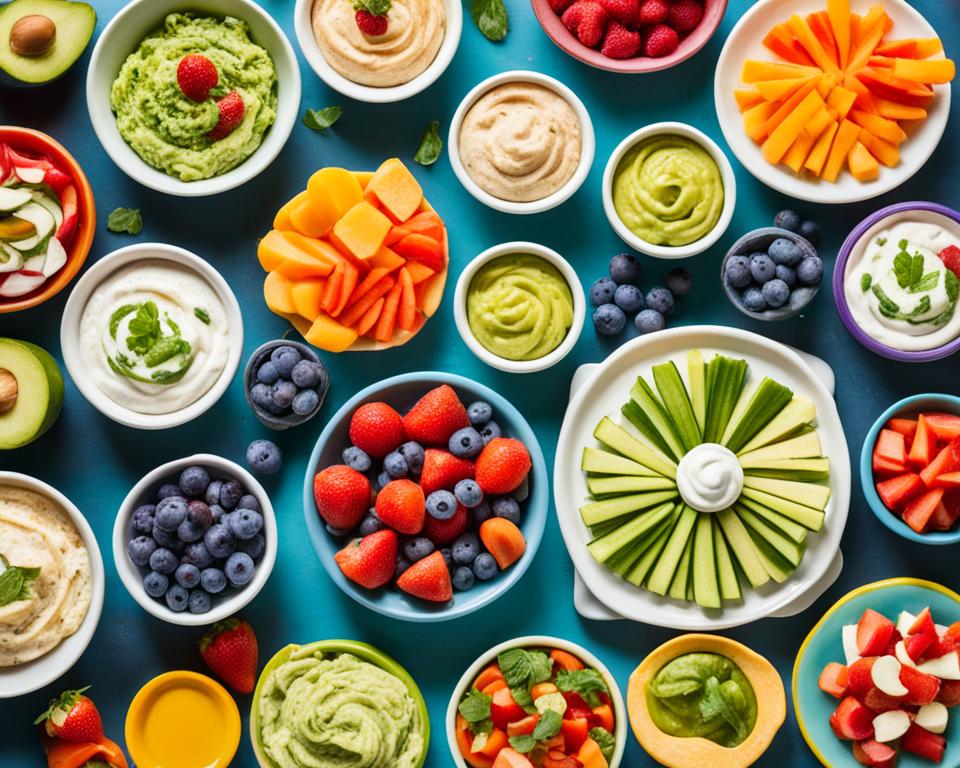Welcome to our article on budget-friendly cooking hacks! Are you looking for affordable meal ideas that won’t compromise on flavor? Look no further. We have compiled a list of kitchen hacks that will not only save you money but also take your meals to the next level. Cooking on a budget doesn’t mean sacrificing taste. With our tips and tricks, you can create delicious and satisfying dishes without breaking the bank.
Key Takeaways:
- Meal planning is essential for saving money and reducing food waste.
- Utilize affordable proteins and versatile staples in your cooking.
- Repurpose leftovers into new and exciting dishes to minimize waste.
- Be a smart shopper by looking for discounts, coupons, and shopping locally.
- Use cooking techniques that stretch your ingredients and enhance flavors.
Meal Planning for Savings
Effective meal planning is a game-changer when it comes to saving money and reducing food waste. By taking the time to plan your meals in advance, you can avoid unnecessary trips to the grocery store and make the most of the ingredients you already have on hand. Not only does meal planning help you save money, but it also allows for more efficient use of your time and resources.
Here are some tips to help you get started with meal planning:
- Create a weekly or monthly meal plan: Sit down and plan out your meals for the week or month. Consider your schedule, dietary preferences, and ingredients that need to be used up. This will help you avoid last-minute takeout and ensure you have all the necessary ingredients on hand.
- Make a shopping list: Once you’ve planned your meals, make a shopping list based on the ingredients you need. Stick to your list while shopping to avoid impulsive purchases. Shopping with a list also helps you stay organized and focused, saving you time and money at the store.
- Take advantage of sales and discounts: Keep an eye out for sales and discounts on ingredients you regularly use. Stock up on pantry staples when they’re on sale, and freeze perishable items for later use. By purchasing items on sale, you can reduce your grocery bill and stretch your budget further.
- Consider batch cooking: Batch cooking involves preparing larger quantities of food at once and dividing it into individual portions for later use. This is especially useful for busy individuals or families who may not have time to cook every day. By batch cooking and freezing meals, you can save both time and money.
Meal planning not only helps you save money and reduce food waste but also encourages healthier eating habits. By planning your meals in advance, you’re more likely to choose nutritious options and avoid relying on convenience foods. Plus, having meals prepared in advance makes it easier to stick to your dietary goals.
Cooking with Affordable Ingredients
When it comes to cooking on a budget, utilizing affordable ingredients is a game-changer. By incorporating budget-friendly ingredients into your meals, you can create delicious and nutritious dishes without breaking the bank. From affordable proteins to versatile staples, let’s explore how these ingredients can elevate your cooking while keeping costs down.
Affordable Proteins
Proteins are essential for a well-balanced meal, but they can often be costly. Luckily, there are budget-friendly options that pack a punch in terms of flavor and nutrition. Consider incorporating the following proteins into your cooking:
- Eggs: Versatile and protein-packed, eggs are an affordable option that can be used in various recipes. Whether you’re making omelets, frittatas, or egg-based dishes, eggs are an excellent choice.
- Canned Tuna: A pantry staple, canned tuna is not only affordable but also a great source of protein. Toss it in salads, mix it into pasta dishes, or make a flavorful tuna melt.
- Inexpensive Cuts of Meat: Opt for budget-friendly cuts of meat, such as chicken thighs, beef chuck, or pork shoulder. These cuts may require longer cooking times but can result in tender and flavorful dishes.
With these affordable proteins, you can create hearty and satisfying meals without straining your budget.
Versatile Staples
Incorporating versatile staples is another key element of budget-friendly cooking. These ingredients provide a solid foundation for a wide range of dishes and can be purchased at affordable prices. Consider stocking your pantry with the following staples:
- Rice: A pantry staple in many cuisines, rice is an incredibly versatile ingredient. Use it as a base for stir-fries, serve it with curries, or use it to make comforting rice bowls.
- Beans and Lentils: Packed with protein and fiber, beans and lentils are not only nutritious but also budget-friendly. Add them to soups, stews, salads, or make bean burgers for a satisfying and affordable meal.
- Seasonal Produce: Opt for seasonal fruits and vegetables to save money and enjoy the best flavors. Seasonal produce tends to be more affordable and can add freshness and variety to your dishes.
By incorporating these versatile staples into your cooking, you’ll have a solid foundation for creating flavorful and nutritious meals on a budget.
Now that we’ve explored budget-friendly proteins and versatile staples, let’s see how these ingredients come together in a delicious and cost-effective recipe.
| Recipe | Ingredients | Preparation Time | Servings |
|---|---|---|---|
| Veggie Stir-fry with Rice | – Assorted vegetables (bell peppers, carrots, broccoli, snap peas) – Tofu or your choice of affordable protein – Cooked rice – Soy sauce or teriyaki sauce – Garlic and ginger (optional for added flavor) |
25 minutes | 4 servings |
Instructions:
- Cut the vegetables into bite-sized pieces and cube the tofu or your choice of protein.
- In a large skillet or wok, heat some oil and sauté the garlic and ginger until fragrant (optional).
- Add the vegetables and protein, stirring frequently until cooked to your desired level of crispness.
- Drizzle soy sauce or teriyaki sauce over the stir-fry and mix well.
- Serve the stir-fry over cooked rice for a complete and budget-friendly meal.
With just a few affordable ingredients, you can create a delicious and satisfying veggie stir-fry that will impress your taste buds without breaking the bank.
Making the Most of Leftovers
Don’t let leftovers go to waste! At [Brand Name], we believe in repurposing leftovers to reduce food waste and save money. By getting creative with leftover ingredients, you can create new and exciting dishes that your family will love.
One creative way to repurpose leftover proteins is by incorporating them into salads, sandwiches, or stir-fries. Sliced grilled chicken or beef can add a hearty protein boost to a refreshing garden salad. Leftover roasted turkey or ham can be layered with cheese and veggies for a delicious sandwich. And diced leftover pork or beef can be stir-fried with fresh vegetables and served over rice or noodles.
If you have leftover vegetables or grains, there are plenty of innovative ways to use them in your meals. Leftover roasted vegetables can be pureed into a flavorful soup or added to a hearty grain bowl. Cooked rice or quinoa can be transformed into a fried rice dish with the addition of sautéed veggies, scrambled eggs, and soy sauce.
Additionally, don’t forget to make flavorful soups or stews using vegetable scraps and meat bones. Simmering leftover vegetable peels, herb stems, and meat bones in a pot of water can create a rich and nourishing broth that can serve as the base for a variety of soups and stews. Add in any leftover meats, vegetables, and grains, and let the flavors meld together for a comforting meal.
We understand the importance of reducing food waste and maximizing the use of ingredients. That’s why we encourage you to get creative and repurpose your leftovers into new and exciting dishes. By doing so, you not only reduce food waste but also save money and stretch your ingredients further.
| Leftover Ingredients | Repurposed Dish |
|---|---|
| Grilled Chicken or Beef | Chicken or Beef Salad |
| Roasted Turkey or Ham | Turkey or Ham Sandwich |
| Pork or Beef | Stir-fried Pork or Beef with Vegetables |
| Roasted Vegetables | Pureed Vegetable Soup or Grain Bowl |
| Cooked Rice or Quinoa | Fried Rice |
Repurposing leftovers not only adds variety to your meals but also helps to reduce food waste and contribute to a more sustainable lifestyle. So, the next time you have leftovers, get creative and transform them into delicious and fulfilling dishes.
Smart Shopping and Budgeting
When it comes to budget-conscious grocery shopping, a little planning and strategic thinking can go a long way. By incorporating some simple tricks into your shopping routine, you can save money without compromising on quality. Here are our top tips for smart shopping and budgeting:
1. Coupon Clipping
Before heading to the store, take the time to browse through local newspapers, online platforms, and mobile coupon apps to find money-saving deals. Clipping coupons can significantly reduce your grocery bill and allow you to stretch your budget even further. Keep an eye out for discounts on your favorite products and take advantage of manufacturer’s coupons for extra savings. Remember to check the expiration dates and any limitations or restrictions that may apply.
2. Store-Brand Alternatives
Another effective way to save money is by considering store-brand alternatives. Many supermarket brands offer high-quality products at a fraction of the cost of name brands. Take a moment to compare the ingredients and nutritional information to ensure they meet your requirements. Often, you’ll find that the taste and quality are comparable, making store-brand items an excellent choice for budget-conscious shoppers.
3. Compare Prices
Don’t be afraid to compare prices and shop around for the best deals. Different grocery stores may offer different pricing on the same items, so take the time to do some research before making a purchase. This simple step could potentially save you a significant amount of money in the long run. Keep in mind that prices may vary depending on the location and availability of certain products.
4. Shop Local
Supporting local farmers, producers, and businesses not only benefits your community but can also be a great way to find fresh and affordable produce. Farmer’s markets and local stores often offer a wide variety of fruits, vegetables, meats, and other products at competitive prices. Not only will you be able to find unique and seasonal items, but you’ll also contribute to sustainable and environmentally friendly practices.
5. Buy in Bulk (with caution)
Buying in bulk can be a cost-effective way to stock up on essential items and save money over time. However, it’s essential to exercise caution and consider your household’s needs and storage capabilities. Some items, such as non-perishable goods and staple pantry items, lend themselves well to bulk purchasing. On the other hand, perishable items or those with shorter shelf lives may lead to waste if purchased in excessive quantities.
6. Plan Ahead
Meal planning not only saves time and reduces food waste but also helps you stick to your budget. By planning your meals in advance, you can create a shopping list based on your planned recipes, eliminating the guesswork and impulse purchases. This method ensures that you only buy what you need, preventing unnecessary spending and reducing the risk of food going to waste.
| Product | Brand A | Brand B |
|---|---|---|
| Milk (1 gallon) | $3.99 | $2.99 |
| Bread (1 loaf) | $2.49 | $1.99 |
| Chicken Breast (1 lb) | $5.99 | $4.99 |
| Apples (1 lb) | $1.99 | $1.49 |
| Pasta (1 lb) | $1.79 | $0.99 |
As the table above illustrates, comparing prices is an effective way to identify potential savings and make informed purchasing decisions. Consider creating a shopping list with the items you frequently purchase and track their prices at different stores to determine where you can get the best value.
“Smart shopping doesn’t mean compromising on quality, but rather finding ways to stretch your budget while still getting the products you need. With a little planning and these budget-conscious grocery shopping tips, you can save money and make the most of your shopping trips.”
Cooking Techniques to Stretch Ingredients
When it comes to budget-friendly cooking, utilizing the right cooking techniques can make all the difference. By using methods such as slow cooking, braising, and roasting, you can transform budget-friendly ingredients into flavorful and satisfying dishes. These techniques not only enhance the taste of your meals but also help reduce food waste, allowing you to make the most out of your ingredients.
Slow cooking is a method that involves cooking food at a low temperature for an extended period. This technique is perfect for cheaper cuts of meat, as it tenderizes them and allows the flavors to develop fully. Whether you’re making a hearty stew or tender pulled pork, slow cooking is a great way to make budget-friendly ingredients shine.
Braising is another technique that can elevate inexpensive cuts of meat. It involves browning the meat in a hot pan and then simmering it in liquid over low heat. This slow cooking process not only tenderizes the meat but also infuses it with rich flavors. From braised chicken thighs to succulent braised beef, this technique is an excellent way to transform budget-friendly proteins into delicious meals.
Roasting is yet another technique that works wonders with budget-friendly ingredients. Whether it’s vegetables or meats, roasting brings out their natural flavors and caramelizes their surfaces, resulting in deliciously crispy and flavorful dishes. From roasted root vegetables to a succulent roast chicken, this technique can turn ordinary ingredients into mouthwatering creations.
Reducing Food Waste with Creative Cooking Techniques
When it comes to reducing food waste, these cooking techniques come in handy. Don’t let wilted vegetables go to waste; instead, incorporate them into flavorful frittatas or savory pies. By adding leftover vegetables to your egg mixture, you can create a hearty and nutritious dish that stretches your ingredients further.
Similarly, when you have leftover proteins like chicken or beef, you can shred them and use them as fillings for tacos, wraps, or sandwiches. By getting creative with using leftovers, you not only minimize waste but also save money and enjoy new culinary creations.
Now let’s take a look at a table summarizing the benefits of these cooking techniques:
| Technique | Benefits |
|---|---|
| Slow Cooking | Tenderizes cheaper cuts of meat |
| Braising | Infuses flavors into budget-friendly proteins |
| Roasting | Enhances the natural flavors of vegetables and meats |
As you can see, these cooking techniques not only help you stretch your budget-friendly ingredients but also enhance their taste and texture. By incorporating slow cooking, braising, and roasting into your cooking routine, you can create delicious and satisfying meals while reducing food waste.
DIY Pantry Staples
Save money and add personal flair to your meals by making pantry staples from scratch. Homemade sauces, spice blends, and salad dressings can be more economical and healthier compared to store-bought options. Customize the flavors to your preferences and enjoy the satisfaction of creating your own pantry staples. With these DIY alternatives, you can elevate your dishes without breaking the bank.
When it comes to homemade sauces, the possibilities are endless. From tangy barbecue sauce to creamy aioli, you can create a wide range of flavors to enhance your meals. Experiment with different ingredients and spices to achieve the perfect balance of taste. Whether you prefer a spicy kick or a sweet and tangy profile, homemade sauces allow you to customize flavors according to your liking.

Spice blends are another pantry staple that can elevate your dishes. Instead of buying pre-packaged spice mixes that may contain additives and preservatives, why not create your own blends using high-quality spices? By combining herbs, spices, and seasonings, you can create unique flavor profiles to enhance your dishes. Whether you’re making a savory rub for grilling or a fragrant blend for curries, homemade spice blends add depth and complexity to your cooking.
Salad dressings are an essential component of any salad, and making your own allows you to control the ingredients and flavors. Say goodbye to store-bought dressings loaded with artificial ingredients and unhealthy fats. With homemade dressings, you can use fresh, wholesome ingredients and experiment with different flavors. From zesty vinaigrettes to creamy Caesar dressings, customization is key in creating the perfect dressing to drizzle over your greens.
By making your own pantry staples, you not only save money but also have the freedom to experiment and create flavors that suit your palate. It’s a rewarding and empowering experience that allows you to take ownership of your meals. So, why not roll up your sleeves and start creating your own homemade sauces, spice blends, and salad dressings?
Conclusion
In conclusion, implementing budget-friendly cooking hacks can not only help you save money but also contribute to a more sustainable lifestyle. By adopting meal planning strategies, utilizing affordable ingredients, making the most of leftovers, shopping smartly, using cooking techniques to stretch ingredients, and creating your own DIY pantry staples, you can enjoy delicious and satisfying meals without breaking the bank.
Meal planning allows you to reduce food waste and save money by organizing your meals in advance and creating shopping lists based on planned dishes. Cooking with budget-friendly ingredients such as affordable proteins like eggs and canned tuna, as well as versatile staples like rice, beans, and lentils, ensures that your meals remain budget-friendly without compromising on flavor or nutrition.
Don’t forget to make the most of leftovers! Repurposing leftover proteins in salads, sandwiches, or stir-fries, and using vegetables and grains in innovative ways can help minimize waste while providing you with creative and flavorful meal ideas. Additionally, implementing smart shopping and budgeting techniques such as using coupons, shopping locally, and buying in bulk can significantly reduce your grocery expenses over time.
Furthermore, utilizing cooking techniques like slow cooking, braising, and roasting can transform cheaper cuts of meat and even wilted vegetables into mouthwatering dishes. Lastly, creating your own pantry staples, such as homemade sauces, spice blends, and salad dressings, not only saves you money but also allows you to customize the flavors to your liking.
By embracing these budget-friendly cooking hacks and making them part of your everyday life, you can enjoy delicious meals, save money, reduce food waste, and contribute to a more sustainable lifestyle. So why not start today and make cooking on a budget an enjoyable and rewarding experience?
FAQ
What are some budget-friendly cooking hacks that can help enhance the flavor of inexpensive ingredients?
There are several budget-friendly cooking hacks that can elevate the flavor of inexpensive ingredients. From meal planning and utilizing affordable proteins to repurposing leftovers and smart shopping, there are plenty of ways to create delicious meals on a budget.
How can meal planning help with savings?
Meal planning is essential for saving money and reducing food waste. By planning your meals in advance, creating shopping lists based on the planned meals, and taking advantage of sales and discounts, you can minimize impulse purchases and make the most of your ingredients.
What are some affordable ingredients to cook with?
Cooking with budget-friendly ingredients is key to keeping costs down. Incorporate affordable proteins like eggs, canned tuna, and inexpensive cuts of meat into your meals. Utilize versatile staples like rice, beans, lentils, and seasonal produce to create delicious and satisfying dishes.
How can I make the most of leftovers?
Leftovers can be repurposed into new and exciting dishes to reduce food waste and save money. Get creative with using leftover proteins in salads, sandwiches, or stir-fries. Use vegetables and grains in innovative ways to create flavorful meals. Additionally, make flavorful soups or stews using vegetable scraps and meat bones.
How can I be a savvy shopper and save money on groceries?
To save money on groceries, look for coupons, discounts, and loyalty programs. Consider purchasing store-brand items and compare prices to find the best deals. Take advantage of farmer’s markets and local stores for fresh and affordable produce. Buying in bulk can also help save money in the long term.
What cooking techniques can I use to stretch ingredients?
Cooking techniques like slow cooking, braising, and roasting can tenderize cheaper cuts of meat and infuse flavors into budget-friendly ingredients. Don’t let wilted vegetables go to waste; incorporate them into flavorful frittatas or savory pies. By utilizing these cooking techniques, you can make the most out of your budget-friendly ingredients and reduce food waste.
Are there any DIY pantry staples I can make to save money?
Yes! You can save money and add personal flair to your meals by making pantry staples from scratch. Homemade sauces, spice blends, and salad dressings can be more economical and healthier compared to store-bought options. Customize the flavors to your preferences and enjoy the satisfaction of creating your own pantry staples.





